初中英语阅读理解之主旨大意题
- 格式:pptx
- 大小:2.59 MB
- 文档页数:35

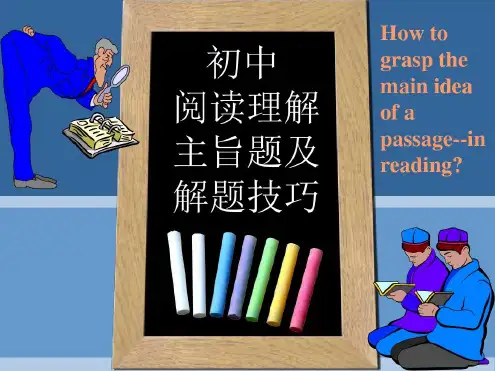
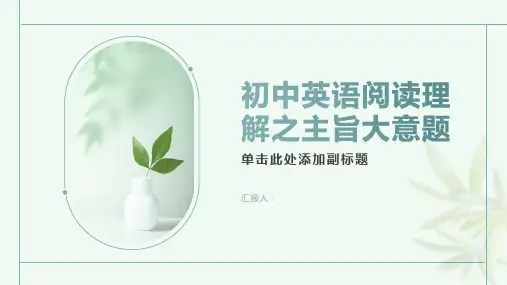
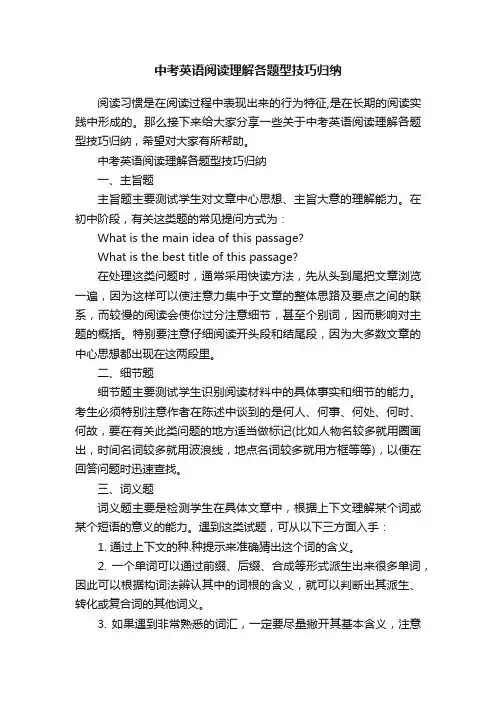
中考英语阅读理解各题型技巧归纳阅读习惯是在阅读过程中表现出来的行为特征,是在长期的阅读实践中形成的。
那么接下来给大家分享一些关于中考英语阅读理解各题型技巧归纳,希望对大家有所帮助。
中考英语阅读理解各题型技巧归纳一、主旨题主旨题主要测试学生对文章中心思想、主旨大意的理解能力。
在初中阶段,有关这类题的常见提问方式为:What is the main idea of this passage?What is the best title of this passage?在处理这类问题时,通常采用快读方法,先从头到尾把文章浏览一遍,因为这样可以使注意力集中于文章的整体思路及要点之间的联系,而较慢的阅读会使你过分注意细节,甚至个别词,因而影响对主题的概括。
特别要注意仔细阅读开头段和结尾段,因为大多数文章的中心思想都出现在这两段里。
二、细节题细节题主要测试学生识别阅读材料中的具体事实和细节的能力。
考生必须特别注意作者在陈述中谈到的是何人、何事、何处、何时、何故,要在有关此类问题的地方适当做标记(比如人物名较多就用圈画出,时间名词较多就用波浪线,地点名词较多就用方框等等),以便在回答问题时迅速查找。
三、词义题词义题主要是检测学生在具体文章中,根据上下文理解某个词或某个短语的意义的能力。
遇到这类试题,可从以下三方面入手:1. 通过上下文的种.种提示来准确猜出这个词的含义。
2. 一个单词可以通过前缀、后缀、合成等形式派生出来很多单词,因此可以根据构词法辨认其中的词根的含义,就可以判断出其派生、转化或复合词的其他词义。
3. 如果遇到非常熟悉的词汇,一定要尽量撇开其基本含义,注意其引申的意义。
四、推断题推断题主要考查学生透过文章的表面文字信息,进行分析、综合、归纳等逻辑推理的能力。
一要抓住选项与选项之间的不同,二要在文中找出与选项对应的内容进行对比。
五、观点态度题观点态度题主要考查学生通过掌握主题思想和具体事实,对作者的观点和态度做出合理推断的能力。

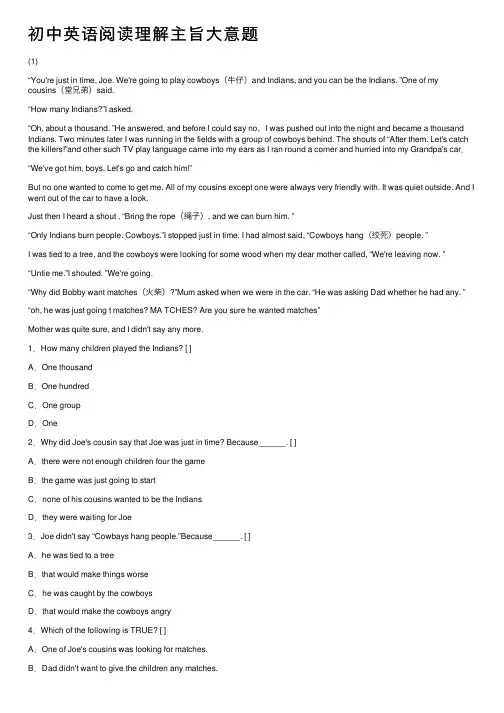
初中英语阅读理解主旨⼤意题(1)“You're just in time, Joe. We're going to play cowboys(⽜仔)and Indians, and you can be the Indians. ”One of my cousins(堂兄弟)said.“How many Indians?”I asked.“Oh, about a thousand. ”He answered, and before I could say no,I was pushed out into the night and became a thousand Indians. Two minutes later I was running in the fields with a group of cowboys behind. The shouts of “After them. Let's catch the killers!”and other such TV play language came into my ears as I ran round a corner and hurried into my Grandpa's car.“We've got him, boys. Let's go and catch him!”But no one wanted to come to get me. All of my cousins except one were always very friendly with. It was quiet outside. And I went out of the car to have a look.Just then I heard a shout , “Bring the rope(绳⼦), and we can burn him. ”“Only Indians burn people. Cowboys.”I stopped just in time. I had almost said, “Cowboys hang(绞死)people. ”I was tied to a tree, and the cowboys were looking for some wood when my dear mother called, “We're leaving now. ”“Untie me.”I shouted. ”We're going.“Why did Bobby want matches(⽕柴)?”Mum asked when we were in the car. “He was asking Dad whether he had any. ”“oh, he was just going t matches? MA TCHES? Are you sure he wanted matches”Mother was quite sure, and I didn't say any more.1.How many children played the Indians? [ ]A.One thousandB.One hundredC.One groupD.One2.Why did Joe's cousin say that Joe was just in time? Because______. [ ]A.there were not enough children four the gameB.the game was just going to startC.none of his cousins wanted to be the IndiansD.they were waiting for Joe3.Joe didn't say “Cowbays hang people.”Because______. [ ]A.he was tied to a treeB.that would make things worseC.he was caught by the cowboysD.that would make the cowboys angry4.Which of the following is TRUE? [ ]A.One of Joe's cousins was looking for matches.C.Bobby wanted to get some matches from his father.D.Mum didn't think children should play with matches.5.The name of the story should he“______.”[ ]A.Joe and his cousinsB.Who knows what danger is waiting thereC.Cowboys and Indians is a favourite children's gameD.How cowboys and Indians fought in the pastDCBAB(2)In England, people often talk about the weather because they can experience (经历) four seasons in one day. In the morning the weather is warm just like in spring. An hour later black clouds come and then it rains hard. The weather gets a little cold. In the late afternoon the sky will be sunny, the sun will begin to shine, and it will be summer at this time of a day.In England, people can also have summer in winter, or have winter in summer. So in winter they can swim sometimes, and in summer sometimes they should take warm clothes.When you go to England, you will see that some English people usually take an umbrella (伞)or a raincoat with them in the sunny morning, but you should not laugh at them.If you don't take an umbrella or a raincoat, you will regret (后悔) later in the day.1. Why do people in England often talk about the weather?A. Because they may have four seasons in one dayB. Because they often have very good weatherC. Because the weather is warm just like in springD. Because the sky is sunny all day2. From the story we know that when _________come, there is a heavy rain.A. sunshine and snowB. black cloudsC. summer and winterD. spring and autumn3. "People can also have summer in winter." Means "it is sometimes too ______in winter."A. warmB. coolC. coldD. rainy4. In the sunny morning some English people usually take a raincoat or an umbrella with them because ________.A. their friends ask them to do soB. it often rains in EnglandC. they are going to sell them5. The best title (标题)for this passage is ________.A. Bad SeasonsB. Summer or WinterC. The Weather in EnglandD. Strange English PeopleKEY: ABABC(3)To find out whether bees(蜜蜂)can see colours, the following experiment is made. A round table is put in a garden, and on the table is a piece of blue cardboard(硬纸版)with a drop of syrup(糖浆)on it. After a short time, bees come to the syrup. The bees then fly to their hive(蜂房)and give the syrup to other bees in the hive. Then they return to the feeding-place which they have found. After a while, the blue cardboard with the syrup on it is taken away. Instead of this card, a blue card is now put on the left side of the first feeding-place and a red card to its right. These new cards have no syrup on them. Very soon bees arrive again, and fly straight to the blue card. None go to the red card.Picture 11. How many cards do you need to prepare for the experiment?A. Two: one blue and one redB. Three: two blue and one redC. Three: one blue and two redD. Four: two blue and two red2. If Picture 1 below shows the table top during Step 1 of the experiment, which of A, B, C,D in Picture 2 shows the table top during Step 2?Picture 23. During Step 2 of the experiment, the bees go to ________.A. the blue card with syrup on itB. the new blue card with no syrup on itC. the empty space where the original(原先的)blue card wasD. the new blue card with syrup on it on the left of the red card4. The experiment has proved(证明)that bees ________.A. cannot see colorsB. can see colorsC. can not see blueD. cannot see red5. Which of the following is the best title for the passage?A. Bees Love BlueB. Bees Love SyrupC. Bees, Color and SyrupNow satellites are helping to forecast(预报)the weather. They are in space, and they can reach any part of the world. The satellites take pictures of the atmosphere(⼤⽓), because this is where the weather forms(形成). They send these pictures to the weather stations. So meteorologists(⽓象学家)can see the weather of any part of the world. From the pictures, the scientists can often say how the weather will change.Today, nearly five hundred weather stations in sixty countries receive satellite pictures. When they receive new pictures, the meteorologists compare(⽐较)them with earlierones. Perhaps they may find that the clouds have changed during the last few hours. This may mean that the weather on the ground may soon change, too. In their next weather forecast, the meteorologists can say this.So the weather satellites are a great help to the meteorologists. Before satellites were invented, the scientists could forecast the weather for about 24 or 48 hours. Now they can make good forecasts for three or five days. Soon, perhaps, they may be able to forecast the weather for a week or more ahead(提前).1. Satellites travel _____________.A. in spaceB. in the atmosphereC. above the groundD. above space2. Why do we use the weather satellites to take pictures of the atmosphere? Because __________.A. the weather satellites can do it easilyB. clouds form thereC. the weather forms thereD. the pictures can forecast the weather3. Meteorologists forecast the weather __________.A. when they have received satellite picturesB. after they have compared new satellite pictures with earlier onesC. before they received satellite picturesD. during they study satellite pictures4. Maybe we’ll soon b e able to forecast the weather for ________.A. one dayB. two daysC. five daysD. seven days or even longer5. The main(主要的)idea of this passage is that satellites are now used in _________.A. taking pictures of the atmosphereB. receiving pictures of the atmosphereC. doing other work in many waysSnow fell on the mountain. It snowed and snowed. The snow did not melt(融化). It became deep and heavy. The snow on the bottom pressed (挤压)together., it became ice.The ice was very wide and thick. It began to move down the mountain. It was like a river of ice. It was a glacier(冰河). Sometimes the glacier moved only a few inches(英⼨)each day. As it moved, it took rocks and dirt with it. It changed the land. In some places, it left hills. In some places, when the glacier melted, it made rivers and lakes.A million years ago, there were many big glaciers. Glaciers covered many parts of the world. The glaciers changed the land. Glaciers are still at work today. A glacier in the north of Canada is cutting a new path(路)down the side of a mountain. This glacier will change the land, too.1. The snow that fell on the mountainA. became snowmanB. meltedC. became iceD. turned to rain2. The word in the story that means a river of ice is __________.3. The story says, “The snow did not melt. It became deep and heavy”. The word it means ____.4. Which of the following does this story lead you to believe?A. There are not as many glaciers as there used to beB. Glaciers do not change the land as they move over it.C. Glaciers are found only in warm places.5. How fast did the glacier move? (Which sentence is exactly like the one in your book?)A. Sometimes the glacier moved only once a year.B. Sometimes the glacier moved over ten miles each day.C. Sometimes the glacier moved only a few inches each day.6. The main idea of the whole story is that _______.A. snow is heavyB. the high land never changesC. glaciers changed the landKey: 1.C 2. glacier 3.snow 3.A 4.C 5.C(6)A Leg Walking RightHere are some signs + - x…, the signs are very different. They mean very different things. When you see them, you know what to do. This sign + means that you will add some numerals. This sign—means that you will take one numeral away from another. You will subtract(减去). What will you do when you see x and… ?Our signs are easy to read. They are easy signs to remember. Look at these two signs… .The ancient Egyptians used these signs. A picture of a leg walking to the left told them to add some numerals. A picture of a leg walking to the right told them toIn the 1500s people used this printed(印刷的)sign & to add numerals. After a while the sign began to look like this….Later, the sign became +.How much is 2…2?1. What do you do when you see this sign +?A. Walk awayB. Write a numeralC. Read a signD. Add2. The word in the story that means to take one numeral away from another is _____.3. The story says, “Our signs are easy to read. They are easy signs to remember”. The word they means ______.4. Which of the following does this story lead to believe?A. Egyptians could not add numerals togetherB. All Egyptians had two left legs.C. Our signs are not hard to understand5. What did the sign to add numerals begin to look like(which sentence is exactly like the one in your book)?A. After a while, the sign began to look like this… .B. After a while, the sign began to look like this +.C. After a while, the sign began to look like this &.6. The main idea of the whole story is that ______.A. the signs for adding and subtracting have changed.B. People could not write in the 1500sC. the old signs were good for Egyptians but not for usKey: 1.D 2.substract 3.signs 4.C 5.A 6.A(7)Mexico's neighbours are the United States to the north and Guatemala and Belize to the south. Mexico is about one quarter of the size of the United States. Mexico has more than ninety million people. The language of Mexico is Spanish. This makes Mexico the world's largest Spanish-speaking country.Mexico City is the capital and largest city of Mexico. The city is also very high. It is 7349 feet high (2240 metres). This makes it one of the highest capital cities in the world. The population, of Mexico City grows bigger every day. About thirty million people live there. It has more people than any other city in the world, even more than Tokyo.Mexico also has its specialities. Many of the foods we eat started in Mexico. Foods like beans, maize, avocados, tomatoes, peanuts, chili peppers, vanilla, and chocolate come from Mexico. Mexico is also famous for its cactus (仙⼈掌) plants. Mexico has more kinds of cactus than any other country.(Words: 161 Minutes: 3 )1. Mexico is ____the USA.A. on the south ofB. on the north ofD. as large as2. Mexicans speak______.A. English C. FrenchB. Spanish D. Latin(拉丁语)3. Which of the following is NOT true?A. Mexico City is the capital of Mexico.B. The population of Mexico City is 30,000,000.C. Tokyo is one of the cities with the largest population.D. Mexico City is the highest city in the world.4. Tomatoes were originally (最初) grown in ______.A. AmericaB. SpainC. TokyoD. Mexico5. The best title (题⽬) of the passage is ___.A. Mexico CityB. Mexico's plantsC. MexicoD. Mexico's population[Key] 1. A 2. B 3. D 4. D 5. C(8)Australia has a lot of lovely animals . You cannot find them anywhere else in the world . The most famous ones are kangaroos and koalas.The kangaroo is the symbol of Australia.They have large eyes and eats . They don't walk, they jump.They use their strong back legs . They can jump at 74 kilometres per hour . They can go over nine metres in one jump . Kangaroo mothers have pouches to carry their babies. The babies stay inside to get milk and keep warm.Kangaroos are everywhere in Australia . They are on TV, in books and in the shops . But do you know that millions of kangaroos are killed every year?There are too many of them . There are about 20 to 25 million kangaroos in Australia. That's more than the number of people in the counery. Some kangaroos go humgry because there is not enough food to eat . They break into farms for food Farmers are very angry with them.The koala is another famous Australian animal . They look like bears , and have small eyes and big noses. They eat leaves from gum trees.Koalas have a.They use it to mark their home----"This is my place,you can't come in!" like kangaroos,a koala baby lives in its mother's pouch,too.()1.If we want to see kangaroos and koalas in natural forests. we can go to________.A.ChinaB.FranceC.AustraliaB.It has big eyes and ers.C.It has small eyes and big noses.()3.The work "pouch" means__________.A.育⼉袋B。

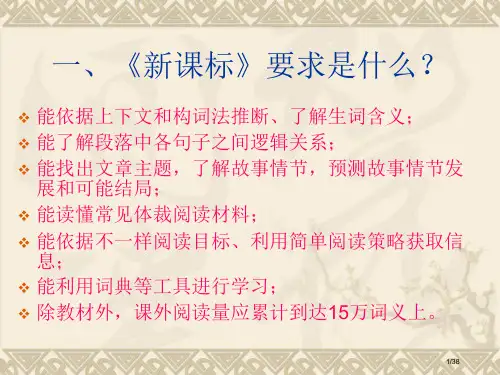
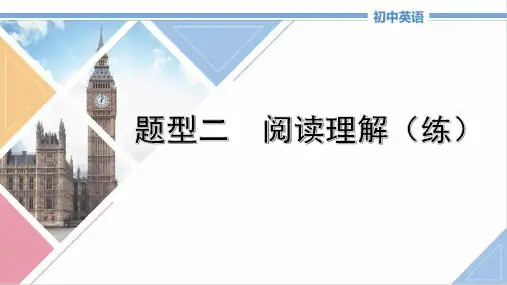
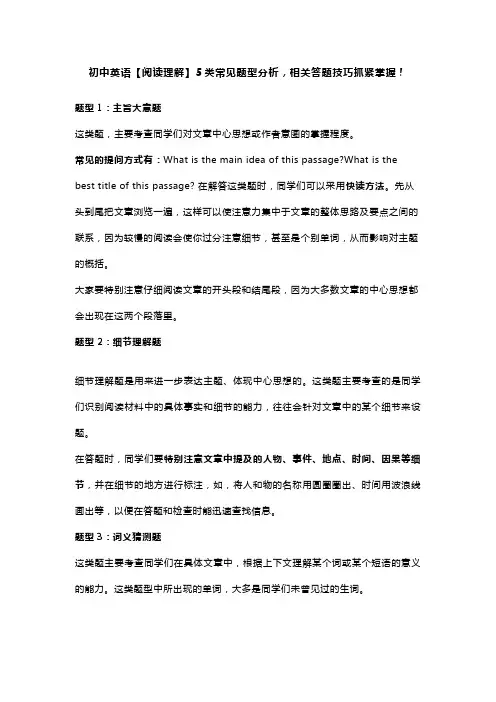
初中英语【阅读理解】5类常见题型分析,相关答题技巧抓紧掌握!题型1:主旨大意题这类题,主要考查同学们对文章中心思想或作者意图的掌握程度。
常见的提问方式有:What is the main idea of this passage?What is the best title of this passage? 在解答这类题时,同学们可以采用快读方法。
先从头到尾把文章浏览一遍,这样可以使注意力集中于文章的整体思路及要点之间的联系,因为较慢的阅读会使你过分注意细节,甚至是个别单词,从而影响对主题的概括。
大家要特别注意仔细阅读文章的开头段和结尾段,因为大多数文章的中心思想都会出现在这两个段落里。
题型2:细节理解题细节理解题是用来进一步表达主题、体现中心思想的。
这类题主要考查的是同学们识别阅读材料中的具体事实和细节的能力,往往会针对文章中的某个细节来设题。
在答题时,同学们要特别注意文章中提及的人物、事件、地点、时间、因果等细节,并在细节的地方进行标注,如,将人和物的名称用圆圈圈出、时间用波浪线画出等,以便在答题和检查时能迅速查找信息。
题型3:词义猜测题这类题主要考查同学们在具体文章中,根据上下文理解某个词或某个短语的意义的能力。
这类题型中所出现的单词,大多是同学们未曾见过的生词。
在做题时,大家可在该词出现的上下文中去寻找线索,通过上下文的语境,推断出该词的真正含义。
最后,记得要将“释义”代入文中,进行检验、比较,直到得出该词的确切含义。
在推断时,大家可从以下几个方面入手:(1)通过因果关系猜词如果生词附近出现了because,as,since,for,so,thus,as a result,of course,therefore等关联词,同学们可以通过找出生词与上下文之间的逻辑关系,推断生词的词义。
例如:You shouldn't have blamed him for that,for it wasn't his fault.其中,通过for引出的句子所表示的原因(那不是他的错),大家便可猜出blame的词义是“责备”。
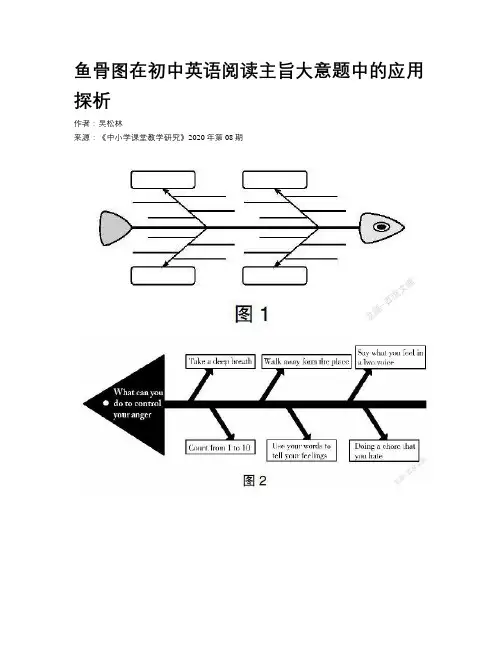
鱼骨图在初中英语阅读主旨大意题中的应用探析作者:***来源:《中小学课堂教学研究》2020年第08期【摘要】魚骨图是一种使复杂文章简单化、抽象问题具体化的解决文章主旨大意题的分析手段。
在教学时,教师可以运用鱼骨图呈现初中阅读文章的结构——“总—分”“分—总”“总—分—总”“并—列”,提炼出更加具体和高效的理解文章的方法,教会学生定位文章主题句的位置,或者找出紧密联系的关键词,从而更准确地概括文章的主旨。
鱼骨图的应用,可以激活学生的阅读思维,充分发挥学生的主动性,提高理解文章的动力。
【关键词】初中阅读;主旨大意题;鱼骨图【作者简介】吴松林,二级教师。
【基金项目】广西基础教育教学改革质量提升项目“基于核心素养的初中‘普职融通’课程模块化实施的探索与实践”阅读理解题已成为中考英语的重要组成部分。
在英语阅读理解中,主旨大意题主要考查学生对文章主题和中心思想的提炼与概括,是整体把握文章写作思路、分析文章逻辑和定位文章细节的基础。
因此,主旨大意题对阅读理解所有题型的解题具有举足轻重的作用。
鱼骨图是一种能够将抽象、复杂的问题用具体、形象的方式表现出来的图形。
借助鱼骨图,我们可以将文章结构以直观、简洁的形式呈现出来,为学生提供高效的解题思路,提高他们对主旨大意题的解题能力。
一、鱼骨图来源及分类鱼骨图由日本管理大师石川馨先生发明,是一种发现问题“根本原因”的方法,又名“因果图”。
它看上去有些像鱼骨,问题或结果通常标在鱼头处;鱼骨上长出鱼刺,按出现机会多寡列出产生问题的可能原因,有助于说明各个原因是如何影响后果的(如图1)。
鱼骨图一般分为三类,即整理问题型、原因型和对策型。
整理问题型鱼骨图常用于各要素与特性值之间不存在因果关系而是结构构成关系的情况;原因型鱼骨图是鱼头在右,呈现由因至果的逻辑关系;对策型鱼骨图是鱼头在左,凸显由疑问到解题思维的形成过程。
问题的特性总是受到一些因素的影响,画鱼骨图时要找出这些因素,整理成层次分明、条理清楚的结构,能够透过现象看本质[1]。
初中英语阅读理解4大题型解题理解一、主旨大意题要求在理解全文的基础上对全文进行高度概括或总结。
题干:Main idea, topic, title, purpose, aim, means to解题思路:1、寻找主题句,从而抓住全段中心思想,常见位置是段首句或第二句,但也可能在段尾或段中。
2、概括全文,寻找文章中心思想。
各段落中心句的整理归纳便是文章的中心思想。
3、把握文章的体裁,分清文体,确定思维方向。
4、体会作者的写作意图和所要表达的思想感情,辨清褒贬态度。
干扰项:可能是文中某个具体事实或细节;可能是从文中某些(不完全的) 事实或细节片面推出的错误结论;可能属非文章事实的主观臆断。
常见题型:1.主题型:What’s the main idea of this passage ? (这篇文章的主要思想是什么?)What does this passage mainly discuss? (这篇文章主要讨论了什么?)What’s the topic of this passage ? (这篇文章的主题是什么?)2.标题型:What’s the best title?(最佳的标题是什么?)The best title for this text is (to tell ) ______. (这段文字的最佳标题是_____)The main purpose of this text is ______.(这段文字的主要目的是?)3.目的型:The author’s purpose of writing this text is to______.(作者写这段文字的主要目的是?)What’s the main purpose of the passage?(这篇文章的主要目的是?)二、细节理解题做这种题目要注意注意提干中的标识语,带着问题有目的地寻找某一特定信息。
题干中的标识语就是寻找答案的"路标词",如人物/时间/地点等。
研究性学习——探究初中英语阅读策略(一)I. 教学目标:1.学生了解阅读理解中主旨大意题的常见设问方式;2.学生通过典型实例探究阅读理解中主旨大意题的解题思路;3.学生通过课堂即时训练强化主旨大意题的解题策略。
II. 教学重难点重点&难点:通过典型实例探究阅读理解中主旨大意题的解题策略。
III. 教学过程I. 主旨大意题型初步感知1. 主旨大意题的考察内容所谓主旨大意题,就是指那些针对文章的主要内容、主题、标题或写作目的所设置的问题。
这类题主要考查同学们在理解全文的基础上运用概括、判断、归纳、推理等逻辑思维方法对文章进行高度概括或总结的能力。
2. 主旨大意题的题干表现形式2.1 主要内容型:What is the passage / text / article mainly about?What is the main / general idea of this passage?This passage mainly tells us about / that ______.2.2 主题型:What is the topic / subject of the article?Which subject is discussed in the text?2.3 最佳标题型:What is the best title for this text / passage / article?Which of the following would be the best title for this passage?2.4 写作目的型:The purpose of this article / passage / text is to_______.The author’s main purpose of writing the passage is ______.What is the writer’s purpose of writing this passage?The article has been written to explain _______.II. 针对不同文体的主旨大意题解题策略探究在做主旨大意题时,不管是哪一种题型,关键的一步是要找出主题句或和主题有关的关键词,从而把握文章的主旨(main idea)。
初中英语阅读理解真题分析一、题目分析本文旨在分析初中英语阅读理解真题,主要探讨其中的题目类型和解题技巧。
二、题目类型初中英语阅读理解真题包含了多种题型,如事实细节题、推理判断题、主旨大意题、图表填空题等。
在解题过程中,我们需要根据文章内容找到正确答案。
1. 事实细节题事实细节题要求我们从文章中找出具体的信息。
解答这类题目时需要仔细阅读文章,注意细节,找到与题目相关的部分,排除其他无关信息。
2. 推理判断题推理判断题要求我们根据文章内容进行推理,判断题目是否正确。
解答这类题目时需要根据文章提供的信息合理推断,注意区分事实和个人观点。
3. 主旨大意题主旨大意题要求我们找出文章的中心思想或主要观点。
解答这类题目时需要整体把握文章内容,注意关键词和段落之间的逻辑关系。
4. 图表填空题图表填空题要求我们根据文章中的图表或表格,填写相关的信息。
解答这类题目时需要仔细观察图表或表格,提取关键信息,填入对应的空格内。
三、解题技巧在解答初中英语阅读理解真题时,我们可以采用以下技巧提高解题效率:1. 快速浏览全文在开始阅读文章之前,可以先快速浏览全文,了解文章的大意和结构,有助于更好地理解和解答题目。
2. 标记关键信息阅读过程中,可以用铅笔或记号笔标记出关键信息,如段落开头的主题句、关键词等,有助于回顾查找答案时更快速地定位。
3. 全文综合推理对于主旨大意题和推理判断题,可以通过全文综合推理的方式来确定答案。
将文章各部分的信息综合起来,进行逻辑推理,找出正确答案。
4. 提前预测答案在阅读问题之前,可以先根据文章的主要内容和线索预测答案。
这样可以提高解题的准确性和效率。
四、总结初中英语阅读理解真题具有一定的题目类型和解题技巧。
通过熟悉各种题型的要求,并运用相应的解题技巧,我们可以提高解题效率,取得更好的阅读理解成绩。
以上为对初中英语阅读理解真题的分析,请参考。
初中英语阅读理解答题技巧一、阅读题的四种题型及命题思路1、主旨大意题阅读理解是对整个文章的目的、意图、观点、立场、态度以及内在的逻辑关系的理解,而不是断章取义的一孔之见,所以统览全篇和问题是很有必要的,这些问题会给你提供信息或暗示文章中的一些重要细节。
在统览全篇的同时要注意抓住文章的中心大意,捕捉主题句,因为一些显性的答案是可以从主题句中直接回答,而隐性的答案则是要通过对全篇的理解才能得出。
主题句一般具有以下特征:①概括全段思想。
②一般位于段首、段尾或位于段中,它通常是用单词、短语表达的。
③解这种题目时,不能只凭文中的只言片语而断章取义,需要在细读全文的基础上,结合所学语言知识、背景知识、生活常识等推理、判断,从而获取文章中内隐的信息。
主旨题常见的命题形式:①The main idea of this text may be…….②This passage is mainly about…….③The author's purpose in writing this text…….④Which of the following is the best title for the passage?⑤What’s the topic of the text?⑥The passage gives us is…...典型例题2005年北京市中考题阅读理解C篇第四题:The greatest help the passage gives us is____.A.to introduce a food guide to the worldB.to provide us with knowledge of six food groupsC.to suggest a way of eating for a healthy lifeD.to find the main cause of some serious diseases答案为C。
初中英语阅读理解中的常见题型总结阅读理解是英语考试中的重要部分,也是学生们常常遇到的挑战之一。
在初中英语的阅读理解中,有一些常见的题型,熟悉这些题型可以帮助学生更好地应对考试。
本文将总结并介绍初中英语阅读理解中的常见题型。
1. 主旨大意题 (Main Idea)主旨大意题是考察考生对文章内容概括和归纳的理解能力。
它要求考生找出文章的中心思想或总体主题。
通常主旨大意题会出现在文章的开头或结尾。
为了回答这类题目,考生需要认真阅读文章,理解文章的主题,同时要注意作者表达的情感倾向。
2. 细节理解题 (Detail)细节理解题要求考生在文章中找到具体的事实细节。
答题时,学生需要仔细阅读文章,并注意文章中的关键词或关键句子。
有时候,答案可能隐藏在文章的细微之处,需要考生仔细寻找并筛选出有效的信息。
3. 词义推断题 (Vocabulary Inference)词义推断题主要考察考生对词汇的理解以及上下文推断的能力。
学生需要通过上下文中的线索来判断和推测某个词的意思。
为了回答这类题目,学生需要积累一定的词汇量,并能熟练运用上下文推断的方法。
4. 词语搭配题 (Word Collocation)词语搭配题考察考生对词语搭配的掌握程度。
学生需要根据上下文的语境选择合适的词语填空,使句子通顺、意思连贯。
为了顺利解答这类题目,学生需要积累并熟悉常见的词语搭配。
5. 推理判断题 (Inference)推理判断题要求考生通过阅读文章中的线索,进行推理与判断。
学生需要仔细分析文章中的信息,以及作者可推断而不直接明示的细节,从而得出正确的结论。
为了答好这类题目,学生需要养成细心分析和推理的习惯。
6. 作者观点题 (Author's Attitude)作者观点题是考察考生对文章作者态度的理解。
学生需要通过认真阅读文章,推测作者对所描述的事物、事件或观点的态度和观感。
这类题目通常涉及考生对文章的语气、词语选择和修辞手法的分析。